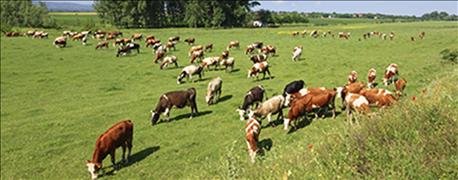January 27, 2016

USDA’s Agricultural Marketing Service withdrew its grass-fed marketing claim standard and the naturally raised marketing claim standard on Jan. 12.
The agency decided these marketing claims did not fit within their statutory mandate.
“Without express authority from Congress – as with the National Organic Program – AMS does not have the authority to define labeling standards and determine if marketing claims are truthful and not misleading,” Craig Morris, deputy administrator of the AMS wrote in a National Farmers Union guest blog. “Therefore, it is inappropriate for the agency to offer these as AMS-defined marketing claims.”

USDA's AMS withdrew its grass-fed marketing standard on Jan. 12.
The voluntary standard for grass-fed marketing claims had been in effect since 2006 and modified in 2007. It stated that livestock marketed under this claim only consume grass or forage after weaned from milk. Also, livestock marketed under this claim needed access to pasture throughout the growing season.
All labeling issues and questions under the marketing claim standards were to be approved by the USDA’s Food Safety and Inspection Service.
In a conference call, Morris said FSIS has the “authority to ensure meat and poultry labels contain information that is truthful and not misleading.”
“By AMS having marketing claim standards for such things as grass fed and naturally raised, people were wrongly thinking AMS had standing statutory authority to determine what standards would merit those other, very controversial claims (non-GE, GMO, responsible use of antibiotics),” Morris said in the call. “The fact is that AMS does not have authority to regulate those terms – no different than we do not have authority to regulate grass-fed or naturally raised.”
Instead, Morris said, AMS audits processes and provides transparency to claims by making standards available on the AMS website.
Going forward, said Tammie Ballard of FSIS labeling and program delivery, producers must explain their definition of grass fed to FSIS for label approval. FSIS does not restrict diet to 100% grass fed.
“FSIS is only considering the feeding protocol in their label approvals — other issues such as confinement; use of antibiotics and hormones; and the source of the animals, meat, and dairy products will be left up to the producer,” the American Grassfed Association wrote in an opinion piece.
Producers who used the AMS grass-fed standard must now update their paperwork with FSIS. Producers who have not used the claim, but wish to, should also contact FSIS. Producers can specify percentage of grass fed on the label.
The American Grassfed Association says the AMS decision is a loss for consumers.
“Grass fed has always been a source of some confusion, but now, with no common standards underpinning it, consumers will find it increasingly difficult to trust the grassfed label,” the association said in a statement.
Morris, in his NFU guest blog, said producers can continue to use the AMS standard until their current certificate expires. They may also use another recognized grass-fed standard or develop their own.
The USDA Grass Fed Small and Very Small Producer Program will remain and producers in this program aren’t required to take any action. AMS will contact them.
Morris said the decision doesn’t impact the agencies’ support of the grass-fed industry.
“… There really isn’t anything different with regard to AMS’ commitment to the grass-fed beef industry or the truthfulness behind the various grass-fed beef marketing programs,” he said in the blog. “Producers still have many options to use grass-fed labels on their products, and consumers can still be confident that grass-fed claims on the products they purchase are verified.”
You May Also Like




